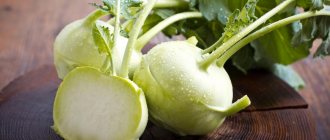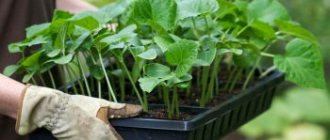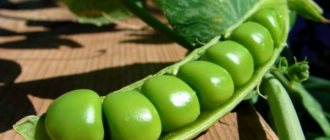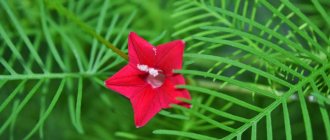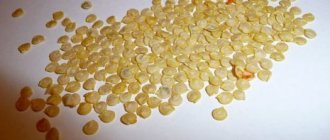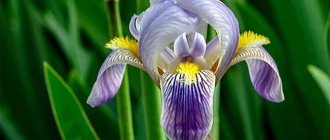General information
There are 700 plant species in nature. They are found in almost all climate zones. For example, in Western Siberia the ringed species is common, in the Moscow region it is decorative.
Sage
- The subshrub is popularly called salvia.
- Almost all species are annuals, but perennial plants are also found in the wild.
- The root system grows shallowly and is located in the upper layers.
- The stem is tetrahedral.
- The leaf shape is ovoid. The leaves are juicy and bright green.
- The flowers are purple and have villi. Other colors are also found, from white to red.
- Begins to bloom in July. Some specimens delight with bright flowers until the onset of frost.
Common types with photos
Of all the varieties, only two types of salvia have medicinal properties. Most often, gardeners grow the following types of plants:
- Drug. Grows up to 70 centimeters. Widely used in medicine and cooking. The leaves are elongated and have a gray-green tint. The stem is thick, with white fibers. Salvia officinalis blooms in June.
Salvia officinalis
- Nutmeg. Found in European countries, the Caucasus, and Central Asia. The stem is pubescent, straight, the leaves are ovate. The white and lilac panicle-shaped inflorescences smell very pleasant. Blooms in summer. For the clary sage plant, planting and care are not particularly difficult.
- Dubravny. Perennial, common in Crimea and Eastern European countries. The branched stem reaches 90 centimeters. The leaves are large, ovate, the flowers are blue. Like the previous species, they emit a delightful aroma. Begins to bloom at the end of summer.
- Narcotic sage is a perennial plant, which is popularly called the plant of fortune tellers. The subshrub contains narcotic components. The root system is woody and has extensive branching. The stem is straight, the leaves are oval, dark green. Blooms exclusively in summer.
Sage Diviners
- Whorled. Homeland - Türkiye, the Caucasus, countries of Southern Europe. Small root system, grows up to 80 cm. Purple inflorescences.
- In Mexico and Texas, mealy sage is common. You can recognize it among hundreds of other species by its erect stem with a small fluff, dark blue panicles, inflorescences, and leaves with wavy edges. Flowering lasts until October.
- Guarani. Another exotic species from South America. The stem length is up to 150 centimeters, the leaves emit a pleasant aroma.
- Silver sage is common in the Mediterranean. The stem is erect. The leaves are ovoid in shape, with pointed ends. Inflorescences are lilac-yellowish.
- In the wild prairies of the United States, lyre-shaped sage is found. Characteristic features of this species are its relatively small height and thick root system. Whorled inflorescences are painted in an unusual purple hue.
Now you know what sage looks like and what varieties exist in nature. Of course, these are not all varieties of sage - we have listed the most interesting ones. Let's move on to the next part of our article - the features of cultivation.
Landing
To understand how to grow sage, consider its preferences. It turns out that the medicinal species grows best in soils with normal acidity from 5.5 to 6.5 pH. For example, loamy, light fertile. Needs sufficient lighting. To ensure that the sage has a bright color and abundant flowering, it is advisable to fertilize the soil before planting. In the fall, it is dug up along with compost or humus, and potassium-phosphorus fertilizer is applied. In the spring, the soil is leveled and broken up with a rake. Nitrogen fertilizers in April-May will also not be superfluous.
sage bush
Garden sage grows in one place for up to 8 years. However, due to the fact that not all perennials tolerate winter well, many species are grown as annuals. The culture germinates excellently, so planting sage without seedlings is quite possible.
The best time to sow seeds in open ground will be the end of March or the beginning of April. True, you still have to use film. An alternative option for sage is to plant and care in the open ground in the fall, under the snow. However, if you hesitate in the spring, you can try sowing the seeds in May. At the end of spring, the long-awaited warmth comes, and you can do without film shelter.
Note! Stratification for sage when growing is not mandatory. It is enough to simply create a bed with a furrow, place the seeds in the soil to a depth of 1-2 cm. The recommended distance between plants is 30 centimeters, and between rows is 50 cm.
Experienced gardeners, before growing sage, check the list of crops that previously grew on the site. For example, planting after the “relatives” of the Yamnotaceae family is undesirable, since sage grows very poorly. But potatoes and cabbage, legumes and onions are quite suitable as predecessors.
Features of reproduction
Sage is a plant that can be propagated by almost all existing methods. In addition to the traditional sowing of seeds in open ground, planting seedlings, dividing the bush, cuttings, and propagation by layering are practiced.
To get seedlings, it is enough to sow the seeds in a suitable container at the end of winter or early March. After 2 weeks, shoots will appear and dive into peat pots in the third week. Propagation by cuttings is possible at any time of the year. By the way, this method is considered one of the simplest. It is enough to cut the semi-lignified shoots into pieces 15 centimeters long and place them in a vessel with water.
Sage flowers
After about 14 days, new roots will appear. In addition, the taproot system of sage is prone to the formation of shoots. In both late summer and early autumn, the bushes are easy to plant.
How does sage reproduce?
Sage reproduces:
- Seeds. It is a natural propagation option for the plant.
- Dividing the bush. Two- or three-year-old bushes are suitable for this; they are cut in half, carefully dug up, and divided into several parts, preserving the roots.
- By cuttings. Cut off the tops of shoots 12–15 cm long, place them in water, and after the roots appear, plant them in the ground.
Vegetative propagation is easier and more reliable.
Planting next to basil, thyme, mint, lemon balm, and rosemary is undesirable. The best predecessors and favorable neighborhood for sage are potatoes, onions, and legumes.
When growing salvia as a potted crop, it is important to immediately find a permanent place for the plant. Any rotation of the pot or transfer to another point in the garden slows down the growing season of the plant.
To see how plant seedlings are picked:
Diseases and pests of sage
Due to the large presence of essential oils, sage protects other plants from harmful insects. Fungal pathogens cause trouble for the culture:
- Rust - brown spots form on the leaves. The leaves dry out and fall off. Treatment consists of removing diseased leaves and using copper-based remedies. Problems arise in rainy years or after plants are overwatered.
- Root and basal rot. Also caused by pathogenic fungi. The lower part of the stem or root turns black, plaque and rot appear. If the damage is severe, the plants die. In rainy summers, preventive spraying is carried out with fungicides - Bordeaux mixture, Oxychom, Ordan.
- With excessive watering, sage seedlings can be affected by blackleg - the plants fall, and a constriction forms at the border of the soil and the ground. Prevention coincides with care - water only after the soil surface has dried.
Application in landscape design
Graceful spikelets of sage combine perfectly with large noble crops. The blue-violet palette serves as an excellent background to warm shades: red, orange and yellow. Here are some successful combinations:
- A charming alpine hill - the sage will be accompanied by hyacinths and daylilies.
- Design of the site in a rustic style - oak sage with herbs and cereals.
- Classics – Lamiaceae next to chrysanthemums, lilies and roses.
Interesting! One- and two-year varieties are most often used; perennials have proven themselves well in creating ridges and mixborders. Neighbors of salvia in an “aromatic garden” or in a spice bed can be mint (pepper, apple mint), thyme and oregano, rosemary and basil.
Practical use
The plant has a firmly established reputation as a garden healer. It contains several essential oils, the composition of micro- and macroelements is impressive. With the help of decoctions and tinctures of sage, respiratory diseases, sore throats, and oral infections are successfully treated. And aromatherapy salvia is a powerful sedative. In cooking it can be used as a spice. By growing perennial species in the garden, you not only decorate the area, but also make a valuable contribution to health.
Collection, storage
The leaves and stem tips have medicinal properties. The collection is carried out during the flowering period, but only the foliage is plucked from young plants. Dry in the shade in the fresh air. You can also use the oven, but the drying temperature should not exceed 60 degrees. The raw materials retain their beneficial properties for 12 months.
Plant care
Sage is an unpretentious home shrub. The rules for caring for it are simple. Attention should be paid to watering, fertilizing, and protection from diseases.
| Watering | The plant is moisture-loving. When we grow sage at home, we spray it regularly. Watering is not carried out daily, but you need to ensure that the soil does not dry out. You can take soft and medium hard water. Once a month you can arrange a shower for salvia. Overwatering is unacceptable: the soil lump should be constantly moist, but not like a swamp in a pot. If there is excess moisture, at best the leaves will lose their aroma, at worst the roots will rot. |
| Top dressing | When growing sage at home, fertilizing is required. The young plant is fed for the first time in early spring. Next, fertilizers are applied every time in the summer, during the flowering period. Both organic and mineral fertilizers are used. First, minerals are added, after 10-15 days - organic matter. |
| Trimming | You can start pruning when the plant reaches two years of life. Trim the branches once every 2 months. Pruning allows you not only to give the shrub a beautiful shape, but also to accelerate the growth of new shoots, making the crown more luxuriant. In addition to decorative pruning, dead branches and dried leaves must be cut off. Do not prune when the plant enters the flowering phase. For the procedure, a well-sharpened tool is used to ensure that the edges of the cuts are smooth and neat. |

